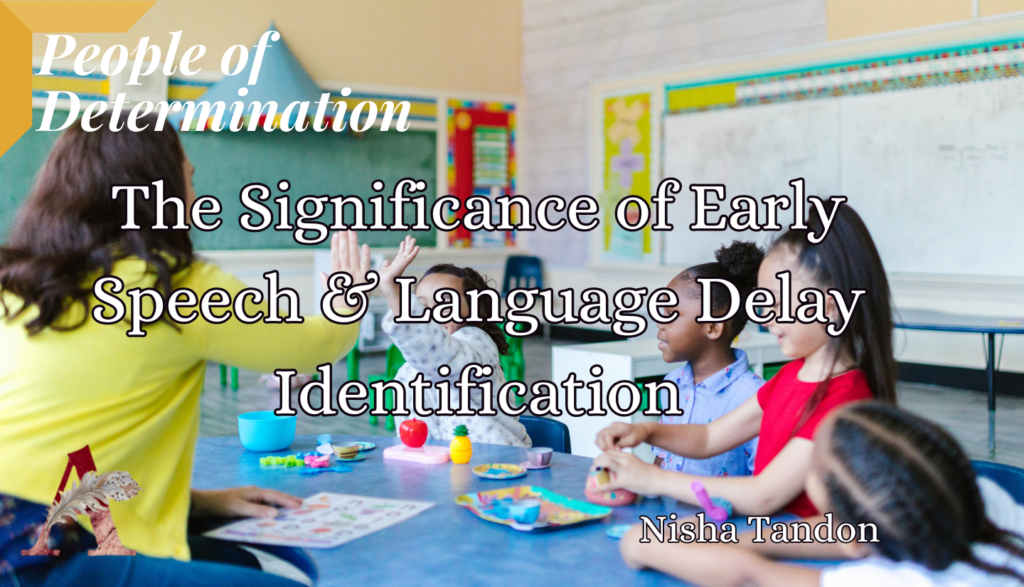
Editor’s Note:
This month, we would like to focus on the significance of Early Speech and Language Delay Identification and Speech Therapy for People of Determination. In this direction, our Dubai Chapter Head, Nisha Tandon has interviewed Ms. Elizabeth Saju, who is a licensed Paediatric Speech and Language Therapist. Here are the excerpts from the interview with nuggets of information.
About Ms. Elizabeth Saju

Ms. Saju is a licensed Paediatric Speech and Language Therapist with experience in educational, clinical, and healthcare settings. She specializes in childhood language disorders, Alternative and Augmentative Communication (AAC), feeding disorders, and cleft palate speech intervention. Elizabeth works at the High Hopes Paediatric Therapy Centre, Dubai, UAE. Elizabeth holds qualifications in Audiology and Speech Language Pathology from Sri Ramachandra University, Chennai, India with affiliations to professional organizations in India and the UAE.
Importance of Early Identification:
Elizabeth feels communication is a fundamental aspect of human interaction and expressing thoughts and emotions. When asked about the importance of early identification of delay in speech, Elizabeth says, for children with speech and language delays, early identification and intervention are crucial for their speech and language development and overall well-being because it allows for timely intervention. Children typically begin developing their language skills at an early age, and identifying the issues early can prevent further developmental gaps, boost confidence, and improve their overall quality of life.
It’s important to identify the reasons for delay in Speech for People of Determination. Speech and language delays in POD can be influenced by a variety of factors, including neurological conditions, hearing impairments, cognitive disabilities, or other developmental disorders.
How Speech and Language Therapy Helps:
Elizabeth feels speech and language therapy is a personalized journey, thoughtfully designed to cater to the unique needs of each child. A qualified speech therapist guides them towards improving articulation, enhancing language comprehension, finding the rhythm in their speech, and fostering connections through communication. In children with complex communication needs, speech therapists may use Augmentative and Alternative Communication (AAC) systems, sign language, or specialized communication devices.
Realistic Goals for Speech Therapy:
In speech therapy, setting realistic goals is crucial. These goals should be SMART – specific, measurable, achievable, relevant, and time-bound. They can encompass a wide spectrum, from refining pronunciation to enhancing social communication. Commencing this journey with a clear starting point and identifying the most significant and meaningful areas for personalized therapy is of utmost importance.
Various Techniques in Speech Therapy:
When asked about the various techniques adopted in speech therapy, Elizabeth shares that speech therapists employ a diverse set of techniques tailored to the individual’s specific needs. For young children, especially during early intervention, play-based approaches prove highly engaging and effective. In a broader sense, speech therapists focus on areas such as speech sounds, language concepts, social skills, stammering, or stuttering, adjusting their methods according to the unique requirements of each individual.
Tailoring Teaching Techniques and Tools:
Elizabeth continues to share that in the realm of speech therapy, the choice of teaching techniques and tools is intricately tailored to the unique diagnosis, all while embracing the principles of neuro-affirming therapy. For instance, a child with autism might experience the benefits of sensory regulation support, aligning with their sensory needs. Similarly, children with complex communication needs may require additional support, such as the incorporation of Augmentative and Alternative Communication (AAC) devices. Seamless communication in an interdisciplinary team is indispensable, particularly when multiple rehabilitation professionals, including occupational therapists, physical therapists, psychologists, or vision therapists, are collaborating to support the individual’s progress.
Importance of Home Intervention:
With my daughter Anoushka, diagnosed with Down syndrome, I have adopted simple home intervention techniques that are imbibed in the regular routine. When questioned about its importance, Elizabeth mentions that home intervention is critical as it reinforces what’s learned in therapy. It enables continuous practice and support. Families can engage in activities that promote speech and language development of their individual child, which may include activities such as reading, storytelling, practicing the target speech sounds, and creating a communication-friendly environment.
Elizabeth also shares various points to keep in mind during home intervention:
– Consistency is key. Stick to the therapy plan and routines.
– Encourage open communication and active listening at home.
– Use visual supports like picture schedules and communication boards to support our visual learners
– Engage in games that involve speaking, listening, and interacting.
– Seek support from the speech therapist for guidance on home activities.
Conclusion:
Elizabeth concludes by saying that early identification of speech delays is like planting a seed of potential in the garden of a child’s future. Timely intervention, through the gift of speech therapy’s tailored techniques and tools, nurtures that seed, allowing it to bloom into improved communication and an enhanced quality of life. But the story doesn’t end there; the power of home intervention, when implemented with care and consistency, adds a thriving layer to this narrative. Ultimately, it’s our understanding of the unique needs and strengths of individuals with additional needs that becomes the sunlight of their overall well-being. Let’s cultivate a world where every voice can find its own beautiful melody.
